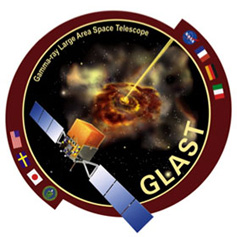

Monday - June 30, 2008
SLAC Today is
available online at:
http://today.slac.stanford.edu
In this issue:
Let's Celebrate GLAST!
GLAST Spacecraft Powered Up and Sending Data
GLAST Prelude Makes SLAC Debut Today
When Computers Look at Art: Image Analysis of the Visual Arts
 |
 |
|
Monday - June 30, 2008 |
 Let's Celebrate GLAST!Join your coworkers and your friends in Panofsky Auditorium at 2:00 p.m. today for a special event to mark the launch of GLAST! Festivities will kick off with a special screening of the GLAST Prelude and footage of the GLAST launch. Remarks from Persis Drell, GLAST Principal Investigator Peter Michelson, NASA GLAST Program Manager Kevin Grady and NASA GLAST Project Scientist and Astrophysicist Steve Ritz will be followed by beverages, snacks and rocket pops out on the SLAC cafeteria patio. Now in orbit 350 miles above the Earth, GLAST has unfurled its solar panel "wings" and is undergoing a series of checks and calibrations. All of the Large Area Telescope's one million channels of electronics have now been powered on. Clearly, it's time to celebrate! |
||
|
|
||
SLAC Receiving
|
GLAST Prelude Makes SLAC Debut Today
As the excitement rose at the Gamma-ray Large Area Space Telescope (GLAST) launch party in Cocoa Beach, Florida, the music swelled. Guests paused their reveling to listen to the GLAST Prelude for brass quintet, Op.12, a twelve minute classical music piece composed especially for the launch and played in unison with a video showing footage of the construction and launch of GLAST, as well as some original graphics created by the NASA Goddard Television and Multimedia Group. The piece was prerecorded by the world-renowned American Brass Quintet of New York and can be viewed online. Pierre Schwob, a SLAC enthusiast and one of the primary donators to the Kavli Institute for Particle Astrophysics and Cosmology, commissioned classical composer Nolan Gasser to write the piece. Gasser, who also works with Schwob on the online ClassicalArchives, says science became "a newfound, intense passion" as he learned more and more about the science of GLAST. "It's a celebration piece," said Schwob, who continued by saying that he hopes the Prelude won't fade out after the launch. He sees the music and video as an investment to further support the science he loves. "I really want it to educate the government, the press, and the public about science and the needs and extraordinary achievements of our scientists." Schwob and Gasser are now preparing for the symphony that Gasser will compose to accompany a 40-minute narrative of the history of the universe. The narrative is being written collaboratively by Schwob and scientist and author Lawrence Krauss. That symphony will be performed by the Boston University Symphony Orchestra in the fall of 2009 to coincide with the release of the first year's data at the GLAST Symposium in Washington D.C. You are invited to enjoy the GLAST Prelude at this afternoon's GLAST celebration, which begins at 2:00 p.m. in Panofsky Auditorium. |
Events
Access (see all)
Announcements
|
| | ||
|
|
||
 <%
Response.AddHeader "Last-modified", getArticleDate()
'Response.AddHeader "Last-modified","Mon, 01 Sep 1997 01:03:33 GMT"
'Monday, December 06, 2010
%>
<%
Response.AddHeader "Last-modified", getArticleDate()
'Response.AddHeader "Last-modified","Mon, 01 Sep 1997 01:03:33 GMT"
'Monday, December 06, 2010
%>View online at http://today.slac.stanford.edu/. |
||